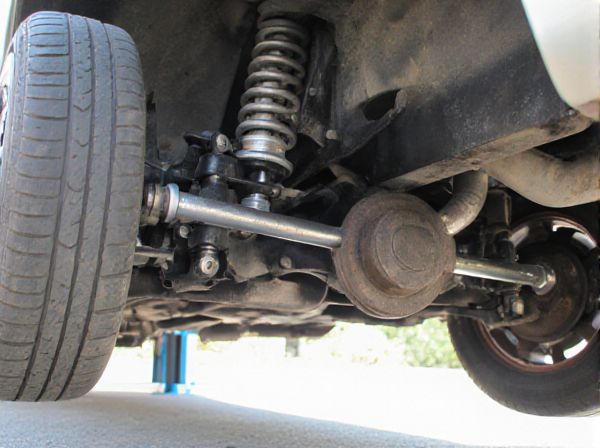
Photo illustration: Drag Link Steering vs Rack End Steering
Drag link steering offers a straightforward mechanism that connects the steering box to the wheel assembly, providing precise control and durability in heavy-duty applications. Rack end steering uses a rack and pinion system that delivers smoother and more responsive handling, especially suited for light vehicles and performance driving. Your choice depends on vehicle type and desired steering feel, ensuring optimal performance and safety.
Table of Comparison
| Feature | Drag Link Steering | Rack End Steering |
|---|---|---|
| Mechanism | Uses a drag link connecting the pitman arm to the steering arm | Uses a rack and pinion system with tie rod ends |
| Steering Precision | Moderate, suitable for heavier vehicles | High precision, best for light and passenger cars |
| Durability | Robust, handles rough terrain well | Less durable under heavy loads |
| Maintenance | Requires regular lubrication and inspection | Low maintenance, sealed components |
| Steering Feel | Heavier, less responsive | Light and responsive |
| Common Usage | Trucks, SUVs, off-road vehicles | Passenger cars, light vehicles |
Introduction to Drag Link and Rack End Steering
Drag link steering systems use a long, horizontal arm connecting the pitman arm to the steering knuckle, providing precise control in heavy-duty vehicles and off-road applications. Rack end steering features a compact, direct connection between the rack and tie rod ends, common in passenger cars for improved steering response and reduced play. Both systems play critical roles in vehicle handling, with drag links emphasizing durability and rack ends optimizing responsiveness.
Key Components of Drag Link Steering
Drag Link Steering features a drag link connecting the pitman arm to the steering arm, essential for transmitting steering motion in trucks and off-road vehicles. Key components include the pitman arm, drag link, tie rods, and ball joints, all crucial for precise control and durability under heavy load conditions. This system contrasts with rack end steering, which relies on a rack and pinion mechanism to convert rotational motion directly into lateral movement.
Key Components of Rack End Steering
Rack end steering features key components such as the rack and pinion gear, tie rods, and inner and outer tie rod ends that work together to translate the steering wheel's rotational motion into lateral movement for precise wheel control. The rack and pinion mechanism ensures direct mechanical linkage, improving steering response and feedback compared to drag link steering, which relies on more components like drag links and idler arms. Enhanced durability and reduced play from high-quality tie rod ends contribute to the efficiency and accuracy of rack end steering systems in modern vehicles.
How Drag Link Steering Works
Drag link steering operates by connecting the steering arm to the pitman arm, transferring the rotational motion from the steering box to the wheels, enabling directional changes. This system relies on a series of mechanical linkages that convert the steering wheel's input into lateral movement across the axle. The drag link's design provides precise control and durability, especially in heavy-duty and off-road vehicles where robust steering response is critical.
How Rack End Steering Works
Rack end steering operates through a linear gear mechanism where the steering wheel's rotational motion turns a pinion gear that moves the rack side to side, directly translating driver input into wheel movement. This system enhances precision by minimizing play commonly found in drag link setups, resulting in improved steering response and control. The rack end's direct connection to the tie rods enables efficient transfer of force to the wheels, making it a preferred choice in modern vehicles for accurate and smooth steering.
Performance Comparison: Drag Link vs Rack End
Drag link steering systems provide more mechanical leverage, resulting in robust handling on rugged off-road terrains but often suffer from increased play and less precise steering feedback. Rack end steering offers a more direct connection between the steering wheel and wheels, delivering improved steering responsiveness, reduced steering effort, and enhanced on-road performance. Performance comparison reveals rack end systems excel in precision and agility, while drag link setups prioritize durability and strength in heavy-duty or off-road applications.
Advantages of Drag Link Steering
Drag link steering offers superior durability and enhanced stability in off-road or heavy-duty vehicle applications, making it ideal for trucks and larger vehicles. It provides a more direct and robust connection between the steering box and the steering arm, resulting in improved steering precision and reduced play. Maintenance is often simpler compared to rack end steering systems, with easier access to components and more straightforward repairs.
Advantages of Rack End Steering
Rack end steering offers precise control and quicker response due to its direct connection between the steering wheel and the wheels, minimizing play and improving handling. This system reduces the number of moving parts compared to drag link steering, resulting in lower maintenance costs and enhanced durability. Its compact design also contributes to better weight distribution and smoother steering feedback, making it ideal for modern vehicles.
Common Applications for Each Steering System
Drag link steering systems are commonly used in heavy-duty trucks, off-road vehicles, and older model cars due to their robustness and ease of repair in rugged conditions. Rack end steering is prevalent in modern passenger cars and light vehicles, offering precise handling, smoother steering response, and compact design ideal for urban driving. Both systems are optimized for specific vehicle types, balancing durability and control based on application requirements.
Which Steering System Is Right for Your Vehicle?
Drag link steering systems offer robust performance and durability, making them ideal for heavy-duty trucks and off-road vehicles that require precise control and resistance to wear. Rack end steering systems provide smoother, more responsive handling, best suited for passenger cars and light-duty vehicles prioritizing comfort and agility. Selecting the right steering system depends on your vehicle's typical use, load demands, and desired driving experience.
 caratoz.com
caratoz.com